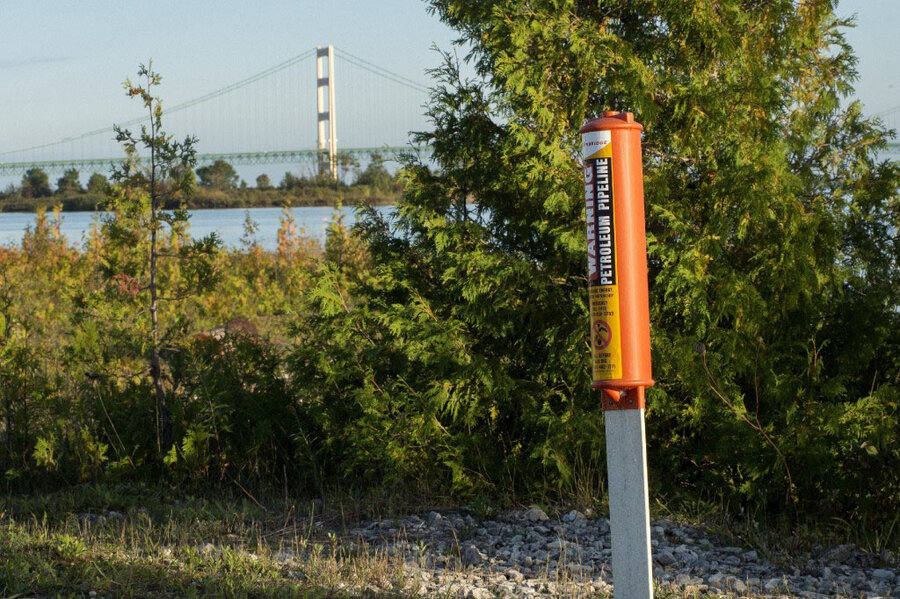Pipeline protests move from North Dakota to Michigan
Loading...
The growing protest movement against US oil and gas pipelines has so far focused on stopping or delaying new construction, with some high-profile successes.
Now, in Michigan, a broad coalition of opponents is entering a new frontier: Pushing to rip out and reroute an existing pipeline – Enbridge Inc.'s aging Line 5, which crosses the Straits of Mackinac.
They fear the pipeline will leak into the Great Lakes, which contain about a fifth of the world’s fresh water and sustain the state’s second- and third-largest industries, agriculture and tourism.
Those concerns – which are shared by two likely candidates for governor – also have far-reaching implications for energy firms and consumers.
Spanning 645 miles, Line 5 carries 540,000 barrels per day of light Canadian crude and refined products between Wisconsin and Ontario, making it a key link in Enbridge's network transporting western Canadian oil to eastern refineries. It also delivers about half the propane used to heat Michigan homes.
Moving the pipeline, built in 1953, would cost Enbridge $4.2 million per mile – or about $2.7 billion total, according to an estimate from IHS Markit analyst Phil Hopkins.
Enbridge spokesman Ryan Duffy said that the line is structurally sound and constantly monitored, tested and inspected to prevent leaks. The firm plans to add 18 additional supports in the Straits this summer, he said.
The unprecedented demands to move an existing pipeline present steep political and regulatory challenges, said Dirk Lever, an analyst with AltaCorp Capital in Calgary.
"Move it? The question is where," he said. "And good luck with building a new pipeline."
The Michigan controversy is only the latest pipeline fight.
Last year, protests by North Dakota's Standing Rock Sioux, a Native American tribe, garnered national attention and delayed the opening of Energy Transfer Partners’ Dakota Access Pipeline, which finally won approval in February.
Another ETP pipeline proposed in Louisiana has drawn protests from flood protection advocates and commercial fishermen.
The Keystone XL pipeline, planned by TransCanada Corp, now faces a political showdown over route approval in Nebraska amid protests from farmers and ranchers.
Campaign Issue
In Michigan, pipeline opponents include regional businesses and churches, as well as local and national environmental groups.
State officials have ordered two independent reports, expected in June – one on the pipeline's reliability and another on potential alternatives if the state moves to revoke easements that allow Line 5 to operate. The reports could fuel a debate that is expected to intensify in the 2018 governor's race.
Many opponents argue the 64-year-old Enbridge pipeline has already outlived its predicted life span. They cite a 2015 interview with an engineer on the original project, Bruce Trudgen, who said that, at the time of construction, the pipeline was expected to last 50 years.
"Common sense dictates that a pipeline which is already 28 percent past its viable life will eventually be decommissioned," said Gretchen Whitmer, a former Michigan senator now campaigning for the Democratic nomination for governor. "Government would be wise to plan for that proactively – before disaster strikes."
Michigan Attorney General Bill Schuette, widely expected to run for governor as a Republican, has also expressed concerns about pipeline.
Enbridge, which operates more than 17,000 miles (28,000 kilometers) of oil and gas pipeline across North America, disputes the assertion that Line 5 has any specific life expectancy.
Regardless of initial predications, Duffy said, new technology developed since the 1950s can now keep pipelines in better condition for longer.
A 1950s engineering feat
Michigan's debate over whether Line 5's age equates to a safety hazard could resonate across a nation crisscrossed with decades-old pipelines. More than half of US pipelines were built in the 1950s or 1960s, according the US Department of Transportation.
When the Enbridge line reaches the Straits of Mackinac, which connect lakes Huron and Michigan, it splits into twin 20-inch diameter steel pipes, hailed as a feat of modern engineering when they were installed in 1953.
Now, opponents here view them as the product of an era in which the damage from oil spills was not well-understood.
Enbridge is still working to overcome public concern over the 2010 failure of its Line 6B pipeline, which leaked 20,000 barrels of crude into Michigan's Kalamazoo River in one of the largest inland spills in US history.
The Straits – five miles wide and 120 feet deep – swirl with strong currents that would disperse contaminants from an oil spill faster than anywhere else in the Great Lakes, according to the National Oceanic and Atmospheric Administration.
The line has never spilled under the Straits, but has leaked at least eight times at other points between 1980 and October 2015, according to the US Pipeline and Hazardous Materials Safety Administration (PHMSA). None of the leaks were larger than 100 barrels.
The leak that raised the most concern was a February 2012 incident in central Michigan that environmentalists contend exposed a flaw in the original construction.
The leak of about 20 barrels was traced to a tear in the pipeline that was estimated to have originated at about the time the line was constructed, according to a PHMSA report on the spill. The tear later spread into a larger crack, causing the leak.
"The nature of the problem is a defect in the pipeline traced to the entire construction period in 1953, so that raised a lot of doubts," said David Holtz, a member of environmental group Sierra Club.
Enbridge declined to comment on the leaks.
The pipeline’s age is only one factor in considering whether it poses an environmental hazard, said Jim Feather, a former president of the National Association of Corrosion Experts and a retired ExxonMobil Corp engineering adviser.
Line 5 has done well in its regular in-line inspections, he said, and has ample protections in place.
"Just because something is old does not mean it's at much greater risk of failure," Feather said.





